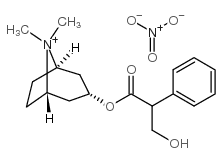atropine methyl nitrate

atropine methyl nitrate structure
|
Common Name | atropine methyl nitrate | ||
|---|---|---|---|---|
| CAS Number | 52-88-0 | Molecular Weight | 366.40900 | |
| Density | N/A | Boiling Point | N/A | |
| Molecular Formula | C18H26N2O6 | Melting Point | 163°C | |
| MSDS | Chinese USA | Flash Point | N/A | |
| Symbol |

GHS06 |
Signal Word | Danger | |
|
Validation of a rapid method of analysis using ultrahigh-performance liquid chromatography - tandem mass spectrometry for nitrogen-rich adulterants in nutritional food ingredients.
J. Chromatogr. A. 1373 , 106-13, (2014) A method for the rapid quantification of 9 potential nitrogen-rich economic adulterants (dicyandiamide, urea, biuret, cyromazine, amidinourea, ammeline, amidinourea, melamine, and cyanuric acid) in five milk and soy derived nutritional ingredients, i.e. whole... |
|
|
Interleukin-18 expression increases in response to neurovascular damage following soman-induced status epilepticus in rats.
J. Inflamm. (Lond.) 12 , 43, (2015) Status epilepticus (SE) can cause neuronal cell death and impaired behavioral function. Acute exposure to potent acetylcholinesterase inhibitors such as soman (GD) can cause prolonged SE activity, micro-hemorrhage and cell death in the hippocampus, thalamus a... |
|
|
Core-shell magnetic molecularly imprinted polymers as sorbent for sulfonylurea herbicide residues.
J. Agric. Food Chem. 63(14) , 3634-45, (2015) Sulfonylurea herbicides are widely used at lower dosage for controlling broad-leaf weeds and some grasses in cereals and economic crops. It is important to develop a highly efficient and selective pretreatment method for analyzing sulfonylurea herbicide resid... |
|
|
4R-cembranoid protects against diisopropylfluorophosphate-mediated neurodegeneration.
Neurotoxicology 44 , 80-90, (2014) Many organophosphorous esters synthesized for applications in industry, agriculture, or warfare irreversibly inhibit acetylcholinesterase, and acute poisoning with these compounds causes life-threatening cholinergic overstimulation. Following classical emerge... |
|
|
MRI visible drug eluting magnetic microspheres for transcatheter intra-arterial delivery to liver tumors.
Theranostics 5(5) , 477-88, (2015) Magnetic resonance imaging (MRI)-visible amonafide-eluting alginate microspheres were developed for targeted arterial-infusion chemotherapy. These alginate microspheres were synthesized using a highly efficient microfluidic gelation process. The microspheres ... |
|
|
Functional Characterization of IPSC-Derived Brain Cells as a Model for X-Linked Adrenoleukodystrophy.
PLoS ONE 10 , e0143238, (2015) X-ALD is an inherited neurodegenerative disorder where mutations in the ABCD1 gene result in clinically diverse phenotypes: the fatal disorder of cerebral childhood ALD (cALD) or a milder disorder of adrenomyeloneuropathy (AMN). The various models used to stu... |
|
|
Bezold–Jarisch reflex in sino-aortic denervated malnourished rats
Auton. Neurosci. 162(1-2) , 48-53, (2011) In this study we assessed the role of Bezold–Jarisch reflex (BJR) in the regulation of blood pressure (BP) of malnourished (MN) and control rats (CN) with sino-aortic denervation (SAD). Fischer rats were fed diets containing either 6% (MN) or 15% (CN) protein... |
|
|
Frequency components of systolic blood pressure variability reflect vasomotor and cardiac sympathetic functions in conscious rats.
J. Physiol. Sci. 61(5) , 373-83, (2011) In this study, after confirming the suppression of autonomic nervous function by isoflurane anesthesia using autonomic antagonists, we pharmacologically investigated the involvement of vasomotor and cardiac sympathetic functions in systolic blood pressure var... |
|
|
Central and peripheral mechanisms underlying gastric distention inhibitory reflex responses in hypercapnic-acidotic rats.
Am. J. Physiol. Heart Circ. Physiol. 300(3) , H1003-12, (2011) We have observed that in chloralose-anesthetized animals, gastric distension (GD) typically increases blood pressure (BP) under normoxic normocapnic conditions. However, we recently noted repeatable decreases in BP and heart rate (HR) in hypercapnic-acidotic ... |
|
|
Post-exposure treatment with nasal atropine methyl bromide protects against microinstillation inhalation exposure to sarin in guinea pigs.
Toxicol. Appl. Pharmacol. 239(3) , 251-7, (2009) We evaluated the protective efficacy of nasal atropine methyl bromide (AMB) which does not cross the blood-brain barrier against sarin inhalation exposure. Age and weight matched male guinea pigs were exposed to 846.5 mg/m(3) sarin using a microinstillation i... |